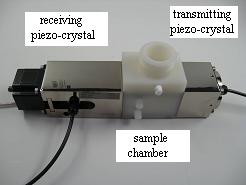DT-600 Acoustic rheometer
DT-600 – Acoustic Rheometer longitudinal
This longitudinal Acoustic Rheometer instrument characterizes visco-elastic properties of Newtonian and non-Newtonian liquids of any composition while treating them as homogeneous.

Several published papers present longitudinal rheology measurements for variety liquids:
- Dukhin, A.S. and Goetz, P.J. Bulk viscosity and compressibility measurement using acoustic spectroscopy,” The Journal of Chemical Physics, Vol.130, Issue 12, (2009).
- Dukhin A.S., “Rheology in longitudinal (ultrasound) mode. Review”, Colloid Journal, vol 83, 1, pp. 1-19, (2021)
- Dukhin, A., Parlia, S., Somasundaran, P., “Rheology of non-Newtonian liquid mixtures and the role of molecular chain length.” J. of Colloid and Interface Science. (2019)
Transmitting piezo-crystal launches ultrasound pulses into the sample while automatically adjusting signal to noise ratio. These ultrasound pulses exert longitudinal stress when propagating through the sample. Visco-elastic response from the liquid reduces magnitude of the pulse and affects speed of the pulse propagation while frequency of ultrasound changes from 1 to 100 Mhz . Subsequently, receiving transducer receives weaker ultrasound pulse, converts it to electric pulse and sends to electronics. Attenuation of ultrasound pulses determines viscous properties of the sample while sound speed – elastic.
Software calculates:
- Liquid compressibility from the sound speed at single frequency.
- Bulk viscosity when liquid is Newtonian.
- Longitudinal viscosity if liquid is non-Newtonian at frequencies 1 to 100 MHz.
- Viscous and elastic longitudinal modulus G’ and G”.
- Verifies Newtonian nature of the liquid when assuming viscosity being independent of frequency for Newtonian liquid.
Required minimum sample volume is below 5 mL.
Total weight is about 20 kg (60 pounds).
